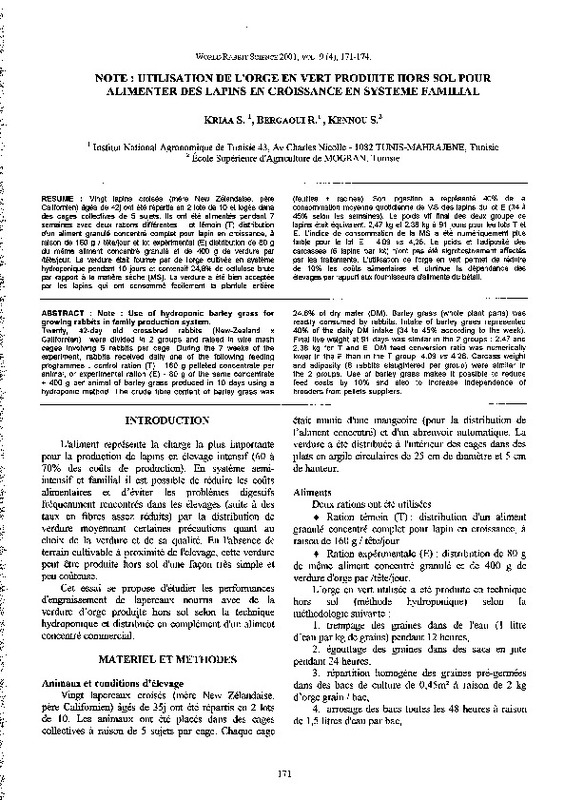JavaScript is disabled for your browser. Some features of this site may not work without it.
Buscar en RiuNet
Listar
Mi cuenta
Estadísticas
Ayuda RiuNet
Admin. UPV
NOTE : UTILISATION DE L'ORGE EN VERT PRODUITE HORS SOL POUR ALIMENTER DES LAPINS EN CROISSANCE EN SYSTEME FAMILIAL
Mostrar el registro sencillo del ítem
Ficheros en el ítem
| dc.contributor.author | Kriaa, S.
|
|
| dc.contributor.author | Bergaoui, R.
|
|
| dc.contributor.author | Kennou, S.
|
|
| dc.date.accessioned | 2011-02-24T14:20:49Z | |
| dc.date.available | 2011-02-24T14:20:49Z | |
| dc.date.issued | 2001 | |
| dc.identifier.issn | 1257-5011 | |
| dc.identifier.uri | http://hdl.handle.net/10251/10018 | |
| dc.description.abstract | [EN] Twenty, 42-day old crossbred rabbits (New-Zealand x Californian) were divided in 2 groups and raised in wire mesh cages involving 5 rabbits per cage. During the 7 weeks of the experiment, rabbits received daily one of the following feeding programmes : control ration (T) - 160 g pelleted concentrate per animal, or experimental ration (E) - 80 g of the same concentrate + 400 g per animal of barley grass produced in 1 O days using a hydroponic method. The crude fibre content of barley grass was 24.8% of dry mater (DM). Barley grass (whole plant parts) was readily consumed by rabbits. lntake of barley grass represented 40% of the daily DM intake (34 to 45% according to the week). Final live weight at 91 days was similar in the 2 groups : 2.47 and 2.38 kg for T and E. DM feed conversion ratio was numerically lower in the E than in the T group: 4.09 vs 4.28. Carcass weight and adiposity (6 rabbits slaughtered per group) were similar in the 2 groups. Use of barley grass makes it possible to reduce feed costs by 10% and also to increase independence of breeders from pellets suppliers. | es_ES |
| dc.description.abstract | [FR] Vingt lapins croisés (mére New Zélandaise, pére Californien) agés de 42j ont été répartis en 2 lots de 1 O et logés dans des cages collectives de 5 sujets. lls ont été alimentés pendant 7 semaines avec deux rations différentes : lot témoin (T) distribution d'un aliment granulé concentré complet pour lapin en croissance, a raison de 160 g I tete/jour et lot expérimental (E) distribution de 80 g du meme aliment concentré granulé et de 400 g de verdure par /tete/jour. La verdure était fournie par de l'orge cultivée en systéme hydroponique pendant 1 O jours et contenait 24,8% de cellulose brute par rapport a la matiére séche (MS). La verdure a été bien acceptée par les lapins qui ont consommé facilement la plantule entiére (feuilles + racines). Son ingestion a représenté 40% de la consommation moyenne quotidienne de MS des lapins du lot E (34 a 45% selon les semaines). Le poids vif final des deux groupe de lapins était équivalent: 2,47 kg et 2,38 kg a 91 jours pour les lots T et E. L'indice de consommation de la MS a été numériquement plus faible pour le lot E : 4,09 vs 4,28. Le poids et l'adiposité des carcasses (6 lapins par lot) n'ont pas été significativement affectés par les traitements. L'utilisation de l'orge en vert permet de réduire de 10% les coOts alimentaires et diminue la dépendance des élevages par rapport aux fournisseurs d'aliments du bétail. | |
| dc.language | Inglés | es_ES |
| dc.publisher | World Rabbit Science. ICTA. UPV | es_ES |
| dc.relation.ispartof | World Rabbit Science | |
| dc.rights | Reserva de todos los derechos | es_ES |
| dc.title | NOTE : UTILISATION DE L'ORGE EN VERT PRODUITE HORS SOL POUR ALIMENTER DES LAPINS EN CROISSANCE EN SYSTEME FAMILIAL | es_ES |
| dc.type | Artículo | es_ES |
| dc.date.updated | 2011-02-24T14:11:40Z | |
| dc.identifier.doi | 10.4995/wrs.2001.462 | |
| dc.rights.accessRights | Abierto | es_ES |
| dc.description.bibliographicCitation | Kriaa, S.; Bergaoui, R.; Kennou, S. (2001). NOTE : UTILISATION DE L'ORGE EN VERT PRODUITE HORS SOL POUR ALIMENTER DES LAPINS EN CROISSANCE EN SYSTEME FAMILIAL. World Rabbit Science. 9(4). https://doi.org/10.4995/wrs.2001.462 | es_ES |
| dc.description.accrualMethod | SWORD | es_ES |
| dc.relation.publisherversion | https://doi.org/10.4995/wrs.2001.462 | |
| dc.description.volume | 9 | |
| dc.description.issue | 4 | |
| dc.identifier.eissn | 1989-8886 | es_ES |








